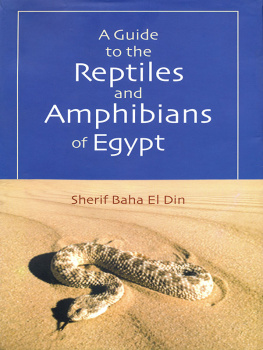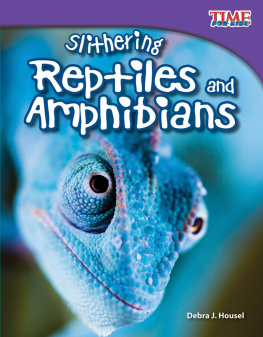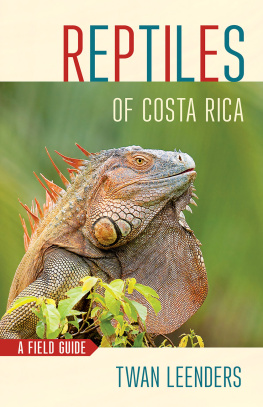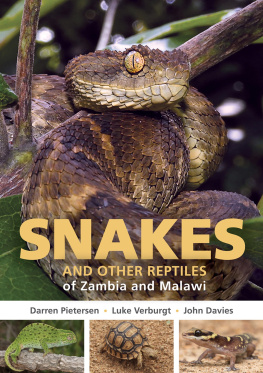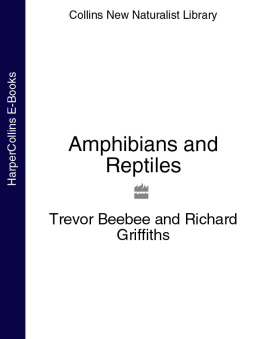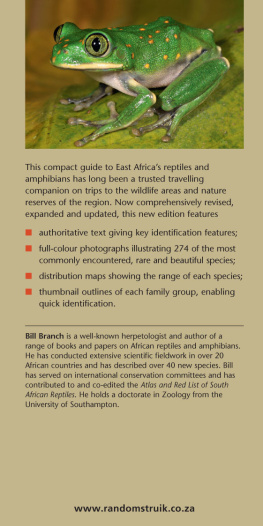A Guide
to the
Reptiles and Amphibians
of Egypt
A Guide
to the
Reptiles and Amphibians
of Egypt
Sherif Baha El Din
The American University in Cairo Press
Cairo New York
Copyright 2006 by
The American University in Cairo Press
113 Sharia Kasr el Aini, Cairo, Egypt
420 Fifth Avenue, New York, NY 10018
www.aucpress.com
All rights reserved. No part of this publication may be reproduced, stored in a retrieval system or transmitted in any form or by any means, electronic, mechanical, photocopying, recording or otherwise, without the prior written permission of the publisher.
Photographs and illustrations by the author unless otherwise indicated.
Dar el Kutub No. 14107/05
e-ISBN 978 161 797 267 6
2 3 4 5 6 7 8 14 13 12 11 10 09
Designed by Sally Makram/AUC Press Design Center
Printed in Egypt
Contents
Many friends and colleagues have helped me throughout this project in various ways. I would like to thank them all: Moustafa Fouda, Waheed Salama, Omar Attum, Ahmed Riad, Tom Cole, Richard Hoath, Mohamed Kassas, Alan Resetar, Hala Barakat, Esther Wenman, John Grainger, John and Patsy Gasperetti, Gabriel Mikhail, Francis Gilbert, Barry Clarck, John Gerhart, David and Heddi Merrie, Ibrahim Helmy, Ahmed Disi, Loutfy Boulos, Mohamed Ibrahim, Kaori Odani, Jeff and Linda Millington, John and Susan Warberton, Jose Rosado, Harold Voris, Steve Goodman, Nick Arnold, Mohamed Gad, John Poynton, Pierre-Andre Crochet, George Zug, Patrick Osborne, Zuhair Amr, Jens Vindum, Van Wallach, Ivan Ineich, Rainer Gnther, Ulrich Joger, Alan Leviton, Osama Ghazali, Saleh Mahmoud, Wolfgang Bhme, Yehuda Werner, Jii Moravec, Herman in den Bosch, Fekri Hassan, Colin McCarthy, Hymen Marx, Lyle and Gloria Rosenzweig, Alison Clarck, Max Kasparek, Stephen Spawls, Wolfgang Wster, Roberto Sindaco, Samy Zalat, Gian Lorenzo, Dave Ferguson, Michael Pearson, Mohamed Sharif Khan, Tim Wacher, Ali Hamdy, John McEachern, Philippe Geniez, Moustafa Saleh, Samir Ghabbour, Ahmed Gamal, Hans Schneider, Jim Buskirk, Paul Williams, Wael Abed, Amr Sharawi, Jacopo Sinibaldi, Neil Hewison, Mohamed El Saghir and all the rangers in the protected areas of Egypt.
I am especially indebted to my wife and family who have been patient and unrelentingly supportive.
Special thanks go to Omar Attum, Roberto Sendaco, Gabriel Mikhail, Mindy Baha El Din and Daniel Mller who provided invaluable photographic materials.
The knowledge of our biodiversity resources is still far from complete. Understanding and accounting for our biodiversity is essential if we are to develop meaningful and effective strategies and actions for their future conservation. The present treatise is an excellent example of biodiversity survey, which updates and consolidates our knowledge about an important part of the Egyptian fauna, the herpetofauna. This fauna deserves special attention particularly the amphibia, turtles and tortoises, which are among the most threatened groups of biota worldwide.
The introductory chapter provides a synoptic outline of the scene of Egypt: its diverse deserts, oases, Nile Valley and Delta, wetlands, and coastal lands. This sets an ecological background of the survey that follows. The main bulk of this book provides an authoritative systematic survey including keys for identification. For every species the text provides detailed diagnostic features with notes on habitat and ecology, conservation status, geographic range, distribution maps in Egypt, and an excellent selection of photographs.
This is a most welcome contribution to the natural history of the Egyptian biodiversity, which provides students, researchers, conservation technicians, and the layman with a valuable and up to date reference.
This outstanding publication deserves well-earned acclaim. The author, Dr. Sherif Baha El Din, and the publisher, The American University in Cairo Press, are to be commended for this valuable contribution to the Egyptian natural history studies.
Mohamed Kassas
Emeritus Professor of Plant Ecology
University of Cairo
Former President of the World Conservation Union (IUCN)

The Egyptian fauna has been documented and investigated for a long time, probably longer than any other fauna in the world, dating back to pharaonic times. The herpetofauna received special attention from the ancient Egyptians, who depicted many reptile species in their inscriptions, such as Cobras Naja sp., Horned Viper Cerastes cerastes, Nile Crocodiles Crocodylus niloticus, and Dab Lizards Uromastyx sp. Throughout the eighteenth and nineteenth centuries Egypt was a popular destination for naturalists and explorers, becoming an important source of material used in describing many taxa after the establishment of the Linnaean nomenclature system. In more recent times, Egyptian herpetofauna has been the subject of four comprehensive reviews. Andersons (1898) classic work was the earliest comprehensive treatment of the Egyptian herpetofauna. Although it is now over one hundred years old, it remains the best researched and documented account of the countrys reptiles and amphibians. Many of Andersons observations on very difficult and complex groups such as Ptyodactylus have proven to be accurate, and reflect his keen understanding and careful scrutiny of these animals. Flower (1933) presented the first herpetofaunal list for Egypt within its modern-day boundaries (Andersons Egypt was more generously proportioned and included parts of todays Sudan). He updated the taxonomy and nomenclature of previously reported taxa, adding several species that were new records for the country. Marx (1968) was mainly concerned with an extensive collection of reptiles and amphibians acquired in Egypt by the United States Naval Medical Research Unit number 3 (NAMRU 3) between the 1940s and 1970s, largely deposited in the Field Museum of Natural History (Chicago) and the National Museum of Natural History (Washington, D.C.). These collections were the first to include extensive material from Egyptian localities outside the Nile Valley and Delta, where much of the previous field-work had been focused. This work presented the first detailed distributional data on the herpetofauna of Egypt and reported several taxa new to the country. The latest account by Saleh (1997) largely summarizes previous knowledge, depending heavily on distributional data presented by Marx (1968), but without much re-evaluation or verification of the records at hand. One of this publications significant contributions is the provision of fairly good photographic representations of many Egyptian taxa. There are also numerous shorter publications that deal with single species, smaller regional faunas, or review the taxonomy of certain groups represented in the country.
After a preliminary evaluation of the contemporary knowledge of local herpetofauna, it was immediately obvious, that despite the fairly extensive coverage Egypt has received over the years, there were many gaps in both taxonomic understanding and geographical coverage. Without a fairly accurate understanding of the basic taxonomic units at hand and their geographical distribution, any subsequent ecological or biogeographical interpretations are likely to be flawed. Some of the existing gaps in knowledge were important elements that would render an ecological interpretation of herpetofaunal communities highly inaccurate. The case of the sister species Acanthodactylus scutellatus

